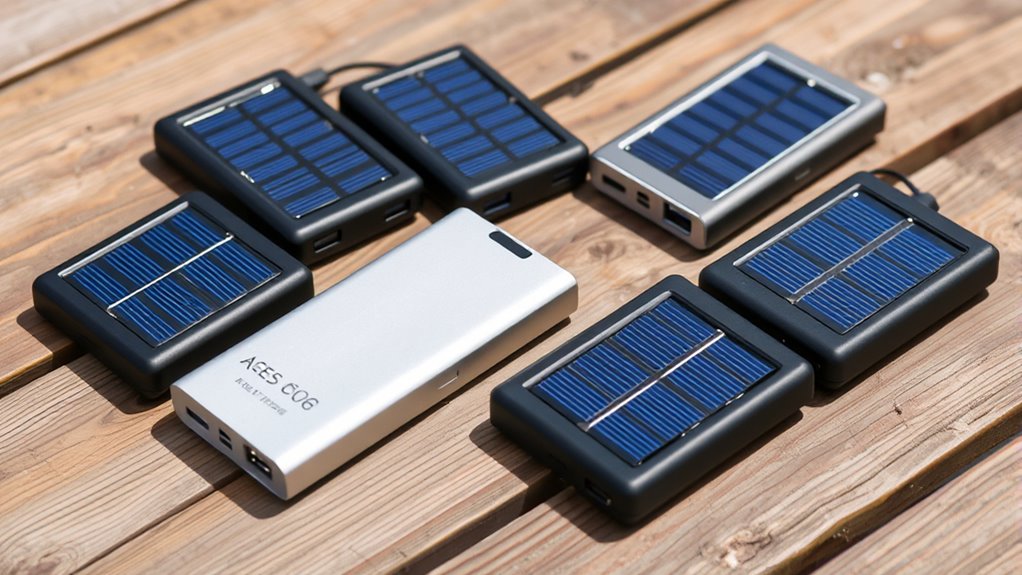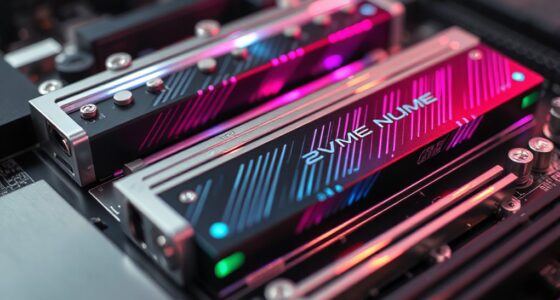If you’re looking for the best solar power banks with AC outlets for off-grid use, I recommend models like the portable 146Wh power station, the GRECELL 1200W 672Wh generator, the compact 88Wh MARBERO unit, a 28,000mAh LiFePO4 power bank with fast charging, and a 200W solar generator with panels. Each offers different capacities, port options, and durability for various needs. Keep exploring, and you’ll discover which one suits your outdoor power demands best.
Key Takeaways
- Evaluate capacity and recharging options to ensure sufficient power for your devices during off-grid use.
- Choose models with multiple AC outlets and versatile ports compatible with various electronics.
- Opt for portable, lightweight designs suitable for outdoor activities and emergency scenarios.
- Prioritize durable, weather-resistant builds for outdoor reliability and longevity.
- Ensure safety features like BMS and digital monitoring for secure, reliable off-grid power management.
Portable Power Station Bank 146Wh with Solar Charging
If you’re looking for a reliable portable power source that can keep your devices charged during outdoor adventures or emergencies, the Portable Power Station Bank 146Wh with Solar Charging is an excellent choice. It offers a 146Wh capacity, enough to power laptops, phones, cameras, and small appliances. Weighing just 3.3 pounds, it’s compact enough to fit in backpacks or suitcases. With seven outputs—including AC outlets, USB ports, and DC—charging multiple devices is effortless. Plus, it supports solar recharging, making it perfect for off-grid use. The digital display keeps you informed about remaining power, ensuring reliable performance when you need it most.
Best For: outdoor enthusiasts, campers, and emergency preparedness individuals seeking a portable, reliable power source for multiple devices.
Pros:
- Compact and lightweight design weighing only 3.3 pounds for easy portability.
- Multiple charging options including AC, USB, DC, and solar compatibility for flexible use.
- Built-in LED flashlight with multiple modes, ideal for outdoor and emergency situations.
Cons:
- Solar panel not included, requiring an additional purchase for solar recharging.
- Limited 146Wh capacity may not power larger or high-demand appliances for extended periods.
- Only two AC outlets, which may be insufficient for multiple high-power devices simultaneously.
GRECELL Portable Power Station 1200W 672Wh LiFePO4 Battery Solar Generator
The GRECELL Portable Power Station 1200W 672Wh LiFePO4 Battery Solar Generator is an excellent choice for outdoor enthusiasts and emergency preparedness, thanks to its reliable 1200W continuous power output and robust battery technology. It supports a variety of devices, including laptops, TVs, and small appliances, through two AC outlets and multiple ports like USB-C, USB-A, and DC. Its LiFePO4 battery guarantees over 3000 cycles, offering long-term durability and safety protections. With fast AC charging, solar compatibility, and a lightweight design, it’s perfect for off-grid adventures, camping, or backup power during outages.
Best For: outdoor enthusiasts, campers, and emergency preparedness households seeking reliable portable power for various devices and off-grid use.
Pros:
- Supports up to 9 devices simultaneously with multiple ports including AC, USB-C, USB-A, and DC outlets.
- Long-lasting LiFePO4 battery with over 3000 charge-discharge cycles ensures durability and safety.
- Seamless power transition during outages with 10ms UPS fast switch for reliable emergency backup.
Cons:
- Weighs 9.5kg, which may be considered heavy for some portable applications.
- Solar panel compatibility requires separate purchase of panels and cables.
- Full charging from AC outlets takes approximately 1.3 to 2 hours, which may be rapid but still requires access to power sources.
MARBERO Portable Power Station 88Wh Camping Lithium Battery Solar Generator
Designed for outdoor enthusiasts and emergency preparedness, the MARBERO Portable Power Station 88Wh stands out with its compact size and versatile charging options. Weighing just 3.2 pounds and measuring 6.5 x 4.6 x 3.1 inches, it’s highly portable with an ergonomic handle. It can quickly charge from 0 to 80% in two hours and supports simultaneous device charging. With multiple output ports, including AC, USB, and car DC, it powers small appliances, phones, tablets, and laptops. The built-in LED lights and SOS mode enhance its emergency capabilities. Its safety features, like BMS and cooling vents, guarantee reliable performance in any situation.
Best For: outdoor enthusiasts, emergency preppers, and travelers needing a portable, versatile power source for small devices and appliances.
Pros:
- Compact and lightweight design makes it easy to carry and store.
- Supports fast charging and multiple device types simultaneously.
- Built-in LED lights and SOS mode enhance emergency usability.
Cons:
- Limited battery capacity (88Wh) may not power larger appliances for long.
- Only 120W peak output, restricting use with high-wattage devices.
- Charging via solar panels requires dedicated panels and may depend on sunlight availability.
Portable Power Station 28,000mAh LiFePO4 Battery with AC & PD Fast Charging
For anyone needing reliable, portable power on the go, the 28,000mAh LiFePO4 portable power station stands out with its fast charging capabilities and versatile output options. Its compact size—about the same as a mobile phone—makes it easy to slip into a backpack, suitcase, or pocket. Weighing just 2.54 pounds, it features 7 output ports, including 2 AC sockets, USB-C, USB-A, and DC, supporting fast charging for most devices. Rapidly charging from 0-80% in just 1.5 hours, it’s perfect for camping, emergencies, or outdoor adventures. The LED display keeps you informed, and multiple charging methods ensure you stay powered wherever you are.
Best For: outdoor enthusiasts, travelers, and anyone needing reliable portable power for camping, emergencies, or on-the-go device charging.
Pros:
- Compact and lightweight design easily fits into backpacks, suitcases, or pockets for portability
- Rapid charging from 0-80% in just 1.5 hours, saving time and ensuring quick power-ups
- Multiple output ports including AC, USB-C, USB-A, and DC support a wide range of devices and fast charging
Cons:
- Limited to a 28,000mAh capacity, which may not be sufficient for high-power devices over extended periods
- No built-in wireless charging feature, requiring wired connections for device charging
- Fanless operation might lead to overheating if used continuously at high loads in hot environments
Solar Powered Generator 200W Peak/100W Rated with Solar Panels and Power Bank
If you’re looking for a reliable and portable power solution for outdoor adventures or emergency situations, this solar-powered generator is an excellent choice. It features a 146Wh capacity, suitable for charging laptops, phones, and small appliances, all while weighing just 3.3 pounds. The included 40W monocrystalline solar panels have a high 20.5% efficiency, even performing well in low light. With seven outlets—AC, USB, and DC—it offers versatile device charging. Its built-in safety features, like a Battery Management System and LED flashlight, guarantee safe operation in any scenario. Plus, it can be recharged via solar panels, making it a sustainable, off-grid power source.
Best For: outdoor enthusiasts, campers, and emergency preparedness individuals seeking a portable, eco-friendly power source for small devices and appliances.
Pros:
- Lightweight and compact at only 3.3 pounds, making it easy to carry and transport.
- High-efficiency 40W monocrystalline solar panels that perform well even in low light conditions.
- Multiple charging options including AC, USB, and DC outlets, along with a built-in LED flashlight for emergencies.
Cons:
- Limited capacity of 146Wh may not support larger appliances or extended power needs.
- Maximum power output of 100W (peak 200W) may restrict usage with more power-intensive devices.
- Battery life and capacity could be insufficient for prolonged off-grid use without frequent recharging.
Factors to Consider When Choosing a Solar Power Bank With AC Outlet

When choosing a solar power bank with an AC outlet, I consider my power capacity needs first to make certain it can handle my devices. I also look at the port options, charging methods, and how portable the unit is for my lifestyle. Ultimately, I check its durability and build quality to make sure it lasts through outdoor use.
Power Capacity Needs
How do you determine the right capacity for a solar power bank with an AC outlet? First, I assess the total watt-hours or milliamp-hours needed to power my essential devices during my typical usage period. I then match the power bank’s capacity with my device’s power consumption, ensuring it can handle both peak and continuous loads. For devices like laptops or small appliances, I check that the capacity supports their use for the required duration. Keep in mind, larger capacity power banks are heavier and less portable, so I balance capacity with portability. Ultimately, I consider if the power bank can recharge my devices multiple times before needing a recharge itself, making sure it fits my off-grid needs efficiently.
Port Selection Options
Choosing the right port options on a solar power bank with an AC outlet is vital for versatile and efficient device charging. I look for models with multiple AC outlets, like dual 110V ports, to power several devices simultaneously. It’s important to check each outlet’s maximum wattage to guarantee I can run high-wattage appliances without overload. A combination of AC, USB, and DC ports offers maximum flexibility for different devices, from smartphones to larger electronics. I also verify if the AC outlets support pure sine wave output, which is essential for sensitive electronics like laptops or medical devices. Lastly, I consider the placement and spacing of outlets, making sure they’re easily accessible and can accommodate larger plugs or multiple cords without hassle.
Charging Methods Flexibility
A solar power bank’s flexibility in charging methods is essential for making sure I can keep my devices powered in any situation. Supporting multiple charging options—like AC wall outlets, USB-C PD, car chargers, and solar panels—means I can recharge it whether I’m indoors or outdoors. Fast charging capabilities, such as reaching 80% in under two hours, make recharging quick and convenient across all methods. Solar compatibility with panels rated between 13-23V guarantees efficient outdoor recharging, especially in emergencies. Having diverse options reduces my dependence on a single power source, increasing the device’s versatility. This flexibility allows me to adapt to various environments and situations, ensuring I stay connected no matter where I am.
Portability and Size
When selecting a solar power bank with an AC outlet, I prioritize its portability and size to guarantee it fits my travel and outdoor needs. I check the weight and dimensions to ensure it’s easy to carry, especially during hikes or trips. A compact design that fits into my backpack, suitcase, or pocket is ideal, allowing me to carry it effortlessly without sacrificing capacity. I look for lightweight materials like aluminum or high-strength plastic to keep it light yet durable. An ergonomic handle or a comfortable grip makes transport even easier. I also consider the size based on my intended use—whether I need quick emergency power or extended off-grid charging—so it matches my mobility requirements without being cumbersome.
Durability and Build
To guarantee my solar power bank with an AC outlet can withstand outdoor conditions and rough handling, I focus on its durability and build quality. I look for a robust outer casing made of high-quality materials like ABS or aluminum, which can resist impacts and harsh environments. Effective thermal management and shock absorption are vital to protect internal components, especially the battery and circuit boards, from temperature fluctuations and physical shocks. Water resistance, rated at IP65 or higher, ensures the device can handle rain, splashes, and dust ingress. A scratch-resistant surface helps maintain its appearance over time, while reinforced ports with strain relief prevent damage from frequent plugging and unplugging. These features collectively contribute to a power bank’s longevity and reliable performance outdoors.
Safety Features Included
Ensuring my solar power bank with an AC outlet has robust safety features is essential for reliable and secure operation, especially outdoors. I look for models with Battery Management Systems (BMS) because they prevent overcharging, overheating, and short circuits, which can damage devices or the power bank itself. Overcurrent and overvoltage protections are also critical—they safeguard my gadgets and the unit during use. Thermal regulation mechanisms help maintain safe operating temperatures, reducing the risk of thermal runaway or internal damage. Short-circuit protection automatically disconnects power if a fault occurs, preventing electrical hazards. Additionally, I check for certifications like UL, CE, or FCC, as they confirm the device meets established safety standards. These features give me peace of mind during off-grid adventures.
Price and Warranty
A solid warranty can make a significant difference in how confident I feel about investing in a solar power bank with an AC outlet. I always check the warranty period—longer coverage usually signals higher quality and manufacturer confidence. It’s important to review what’s covered, such as damages or malfunctions, and any exclusions that might limit protection. I also consider the brand’s reputation; well-rated companies tend to handle warranty claims more smoothly. Knowing if repairs, replacements, or technical support are included gives me peace of mind. Finally, I look at customer feedback to gauge how responsive and easy the warranty process is. A thorough warranty backed by a trusted brand makes my decision easier and ensures I’m protected if issues arise.
Frequently Asked Questions
How Long Do Solar Power Banks Typically Take to Fully Recharge?
Solar power banks usually take between 4 to 12 hours to fully recharge, depending on their capacity and the sunlight conditions. If I’m in direct, strong sunlight, I’ll often see faster charging times, sometimes around 4-6 hours for smaller models. Overcast days slow things down, stretching recharging to 10-12 hours or more. I always recommend placing the bank in direct sunlight for the quickest recharge.
Can Solar Power Banks Power High-Wattage Appliances?
Yes, solar power banks can power high-wattage appliances, but it depends on their capacity and output. I’ve found that most portable options are suited for small devices like phones or tablets. For high-wattage appliances, you’ll need a power bank with a higher wattage output and a robust battery. Always check the specs before plugging in, and don’t expect small solar banks to run heavy-duty devices for long.
Are Solar Power Banks Waterproof or Weather-Resistant?
Imagine your solar power bank as a sturdy ship braving stormy seas—that’s how weather-resistant it should be. Most are designed to withstand rain, splashes, and dust, making them suitable for outdoor adventures. However, not all are fully waterproof. I recommend checking the IP rating; higher ratings mean better protection. If you’re venturing into rough weather, opt for a model explicitly built to weather the storm with you.
What Is the Lifespan of a Lithium-Based Solar Power Bank?
A lithium-based solar power bank typically lasts around 2 to 3 years with regular use, but it can extend up to 5 years if properly cared for. I recommend avoiding overcharging and keeping it in a cool, dry place to maximize its lifespan. Regularly using and maintaining the device helps guarantee your off-grid charging remains reliable for as long as possible.
Do Solar Power Banks Include Surge Protection for Sensitive Devices?
Yes, many solar power banks do include surge protection for sensitive devices. I always look for models with built-in safety features like surge protectors and voltage regulation to prevent damage during power surges or fluctuations. It’s essential for protecting my gadgets, especially when off-grid. Not all models have this feature, so I recommend checking the specifications carefully before purchasing to ensure your devices stay safe and protected.
Conclusion
Choosing the right solar power bank is like planting a seed—nurture it, and it will grow into a reliable source of energy when you need it most. Whether you’re off-grid or just seeking peace of mind, these devices are your solar compass, guiding you through life’s unpredictable terrains. With the right choice, you’ll find that even in the darkest moments, a little sunlight can brighten your path and power your journey forward.











